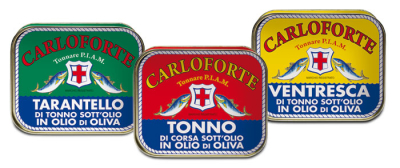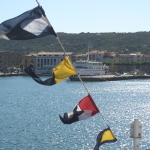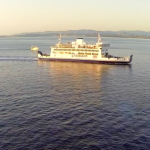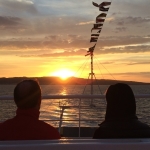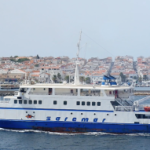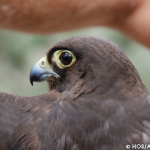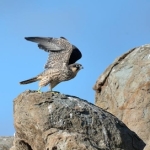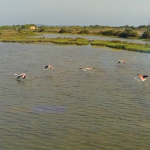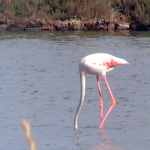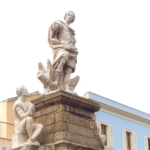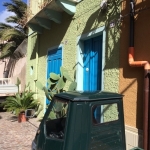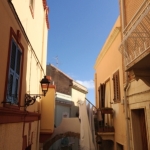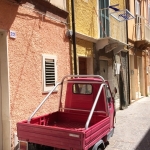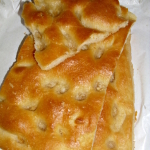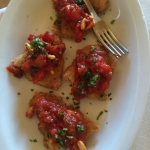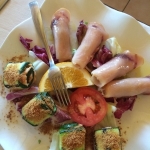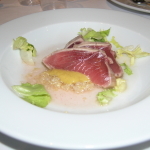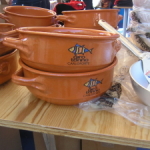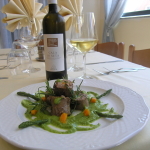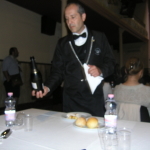Carloforte and Calasetta share Tabarkin origins, founded in 1738 and 1770, respectively, by Genoese settlers from Tabarka, a Tunisian island, who had lived on the island for several centuries, fishing and trading red coral.
The Genoese, great seafarers, traders and fishers, are proud of their origins. Despite the influences — first Arabic and then Sardinian — they maintained many of their traditions (including culinary ones), and, most notably, their own language.
In the two towns, even children speak the Tabarchin dialect correctly and it is taught in schools.
Carloforte, the only city on the island of San Pietro, is three nautical miles from the western coast of Sardinia, reached by a ferry from Porto Vesme or the port of Calasetta.
It takes about 25 minutes on the ferry from Calasetta and can always be crossed in any other weather conditions.
Ferries run frequently, particularly in the summer. Schedules vary by season. Click here to check 2014/2015 timetable.
Carloforte, named for Charles Emmanuel III of Savoy, was built on the design of court engineer Augusto de la Vallée, reminiscent of Genoa and its “carugi” (narrow climbing streets with stairways and steep slopes), the waterfront adorned with palm and ficus trees with a hill behind the town center and a fortress overlooking it.
The town is vibrant and bustling and the island, with its rugged coastlines, many coves, stacks and cliffs is a beautiful sight to behold, by sea or by land.
Its geological configuration is essentially the same as the island of Sant’Antioco, made of ancient volcanic formations, red and gray trachyte and lava rock.
The salt marsh, near the town, is home to a permanent colony of pink flamingos. The Lipu oasis on the island is a protected territory for the beautiful Eleonora’s falcon (Falco eleonorae) and other wildlife. Photo by HOS/ A.Evangelidis - Longufresu Photography / Giovanni Paulis - Invidio / Luigi Palumbo).
Carloforte is the perfect vacation spot whether for a beach vacation or off-season.
Time moves slowly here, and its isolation is definitely relaxing rather than annoying.
There are many anecdotes about Carloforte. My favorite one is a the story of a monument to the king that is on the square facing the sea, welcoming all coming to the island by ferry or boat.
Its statue lacks an arm, which makes it reminiscent of the statue of Admiral Nelson in Trafalgar Square, but the similarity in missing limb has more trivial reasons here. Charles Emmanuel III actually had both arms. It seems that the statue was amputated in a clumsy attempt to hide it from Napoleonic attacks by burying it underground. The hole wasn’t deep enough and one arm stuck out. As a drastic solution, to save the symbol (or at least most of it, we could say), it was cut off. No one knows for sure what ever became of the lost limb.
There are three treat you must not neglect trying when strolling in Carloforte.
- A piece of “figassa,” the traditional Genoese focaccia.
– A piece of chickpea crepe, to eat while you walk, a specialty that can’t be described, you just have to try it.
- A lunch (or dinner) at Andrea’s Antica Tonnara, a restaurant deserving of its renown for its traditional tuna- and bottarga-based dishes, as well as its seasonal vegetables and beans.
One of Carloforte’s distinguishing local trades is tuna fishing, still done with an age-old technique using a maze nets, which is now fortunately regulated with quotas to protect marine life.
In the last weekend of May there is a culinary festival, called the Girotonno, when many international chefs take up the challenge of preparing the best tuna-based dish for a panel of gourmets, bloggers and culinary journalists. The event brings many visitors to the island and the entire archipelago. In 2014, Calasetta became officially part of the side events, serving special tuna-based menus in its restaurants.

